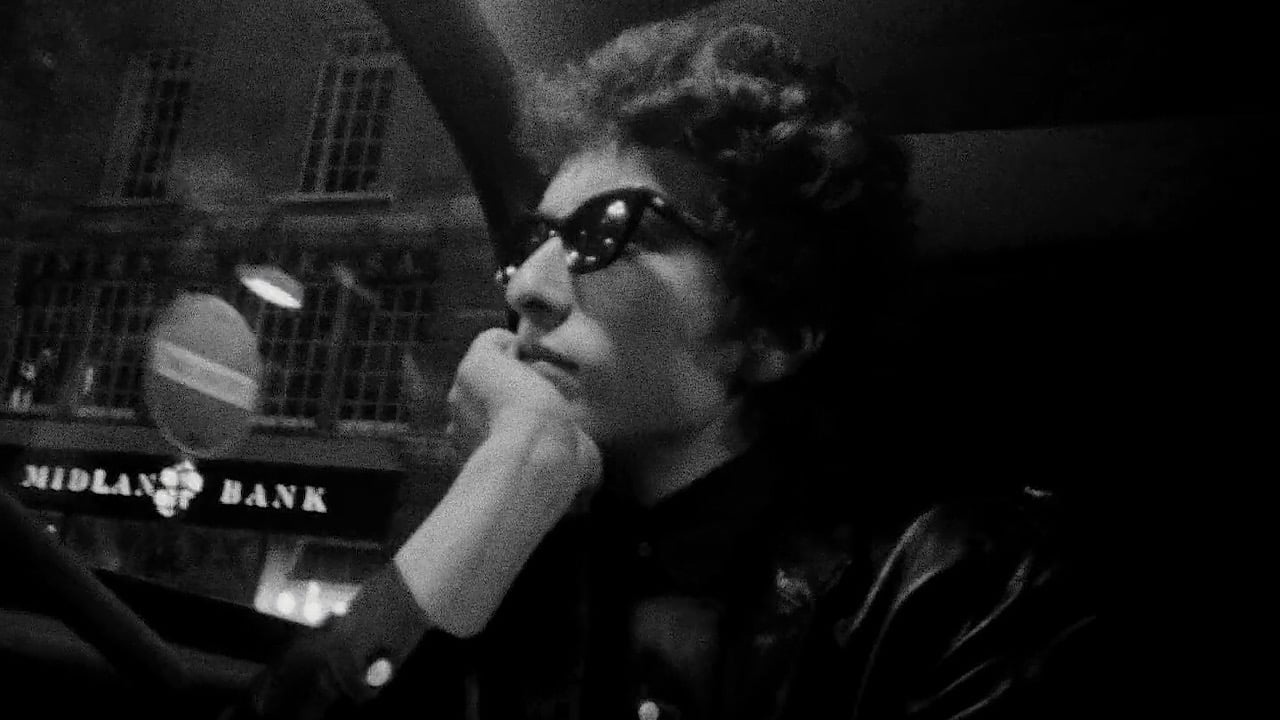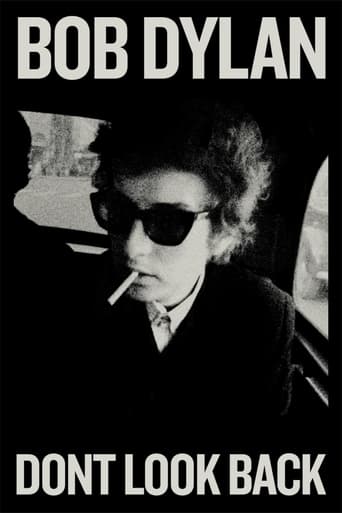

A lot of fun.
... View MoreThis movie was so-so. It had it's moments, but wasn't the greatest.
... View MoreIt is interesting even when nothing much happens, which is for most of its 3-hour running time. Read full review
... View MoreIt's easily one of the freshest, sharpest and most enjoyable films of this year.
... View MoreThis exceptionally stark and unflinching documentary focusses on Bob Dylan's 1965 tour of England when he was at the height of his fame. While there's lots of impressive footage of Dylan singing his poetic songs live, what makes this documentary so striking and startling is the often unflattering way the off-stage Dylan is depicted: He's basically an arrogant, petulant, and self-important little twerp who's rude and dismissive to journalists (Dylan's obnoxious tirade to a hapless reporter from Time magazine is simply priceless!), ignores Joan Baez, treats fans with open contempt, and generally seems quite full of himself. Director D.A. Pennebaker presents a fly on the wall warts'n'all portrait of Dylan that pulls zero punches and scores extra points for its harsh honesty. The raw'n'grainy hand-held cinematography gives the picture a bracing sense of intimacy and immediacy. Moreover, this documentary not only astutely captures just how strenuous and exhausting being on tour in a foreign country can be, but also vividly nails how the pressure of how being a celebrity who's thrust into the limelight at a young age can easily cause a person to implode. Fascinating stuff.
... View More9/6/17. If you like Bob Dylan you will love this. If you don't know who Bob Dylan is you should watch this. This documentary provides a behind- the-scenes look at this iconic balladeer. He was the voice for a whole generation - the Baby Boomers. But, his songs and lyrics still resonate today.
... View MoreD.A. Pennebaker does something different with this clearly- and probably slightly revolutionary- approach to form of cinema verite approach that has as much to do with directorial choice as it does with lack of any budget, and trying to use the best of an all-access-pass to the behind the scenes with an iconoclast like Bob Dylan. As far as I can tell, and maybe it's something sort of naive, there doesn't seem to be an inherent bias on part of the filmmaker. A director of a documentary usually, and most often effectively, will have some kind of subjectivity, or something to say with the collection of interviews and the subject matter. But we never really see Pennebaker skewering either side or the other. For whatever one might perceive to see in Bob Dylan from this time capsule, a man at 23 who was swarmed by media buzz and an acclaim that was staggering (and, from the start for Dylan, more than a bit of a crock), it can't be said that Pennebaker is being unfair to anyone here, not to Donovan or the press or whoever it was that broke that glass in the street.And least of all to Dylan himself; it's because of a stripped-down, bare-boned approach to film-making with a camera in a room getting down the beats- only once does Pennebaker go to a 'flashback' of sorts- that one can't truly and easily pin down what Dylan's all about. And because of the questions raised about the nature of a young artist in a frenzied environment where the pressure to be one thing, i.e. 'folk hero', 'voice of a generation', et all, it's really not simply one of the best rock documentaries, but one of the more insightful, strangely involving documentaries of the past 50 years. We see the fun moments; Dylan having laughs with his fellow musicians or playing guitar with Joan Baez or others; the quiet moments like writing a song on the typewriter; we see the interviewers perplexed at the thought that they're getting prodded by a subject who can disarm their queries at nearly every turn either, arguably, by a stand-offish quality, or just not knowing how to logically answer a question without sounding untruthful. And then the music, on stage, sort of alone in a way with the audience tuned into every word he says as though he's a golden calf.Many scenes are simply fun, experimental. The opening to the film is like a punk rock music video, as Dylan just stands there, awkward and blank-faced, turning over the cards for Subterranean Homesick Blues, with Ginsberg at the end walking across the alley Dylan was standing on. Seeing Dylan with an acute sense of humor is refreshing, and at times it's almost like he uses it as a defense mechanism, as a means of uncertainty to go through fans and the like (the scene with the science student has been described by some as Dylan being simply bullying, but again there seems to not really be any bias- Pennebaker could make this guy look like the fool, but each side is heard, and whoever comes out the wiser once the conversation ends is anyone's call). It might go without saying, however, that some of the material in the film could use some context: Dylan had to go under the same sort of press attention and questions every time, over and over, which was something that Dylan could never really adjust to like other celebrities or popular musicians. Hence a scene like the heated talk with the TIME news reporter; if one knows nothing of Dylan, it might make him seem hostile, or at least uncomfortable. But even with this one sees the nature of an interview where there isn't balance- TIME hasn't listened to much of Dylan's music, and Dylan already has a bias against the magazine for, according to him, not printing the truth as it could. "Do you care about what you do?" the interviewer asks him, to which Dylan takes umbrage. It's almost like watching a loop, where neither side will give in exactly, and it's too complex to tell which side is really wrong or right. Questions between them lead to the audience bringing up questions: is this 'folk hero' really a jerk? Is there some truth to his ranting? What about the generation gap? It's a perplexing scene that is, in its tense manner, spectacular.But as many will want to see in Don't Look Back is the music, the mood of the man who's life was work. It's interesting to see Dylan, in context, on the precipice of his transition from folk to rock, starting a slight disconnect with the folk scene with a few fellow band-mates on the tour, and yet always at his peak playing the same songs he'd played repeatedly for the past few years (Times They Are A'Changin is the same opening number on every date of the tour). There are many pure moments of spontaneous music (Joan Baez singing Turn Turn Turn, and Dylan with It's Alright Ma, I'm only Bleeding ), and practically all the stage stuff, including Hard Rain's Gonna Fall and Blowin in the Wind, two of the most atypical of his songs. At the same time one sees and hears someone like Bob Dylan at the peak of his powers in the 60s, there's the observant dissection of fame- even through Pennebaker's technical imperfections of a loud camera- and if only a small taste of the 'why' that Dylan couldn't ever really be himself, and if so wedged somewhere in a quasi-persona. Don't Look Back is amazing.
... View MoreHistory only matters to the living at least, and among them to those who can consume the packages we devise to understand what happened.Sometimes I really do believe it requires elite skills, a term used by people without the training and discipline. But most of the time, its just about cultural wrappers, and this is such a case. I can imagine a young person, say a 25 year old, watching this and wondering what the big deal was. Why is this pretentious gnome at all interesting?I think you had to be there, which is another way of saying that you had to be culturally tuned to accept the possibility of major change. For whatever reason, we were, from say 65 to 70, a hundred million in the US and countless others elsewhere. And where we invested our hopes was in these artifacts of the popular culture. In films, yes, but more so in the music. It was religious, with the artists serving more as receptacles for what we sent them than as creative geniuses. Well, yes they were that too, but we have many of those today but miss this huge investment.When Dylan made records from about this period on, each of them (until, say he was lost to Jesus) each of them anticipated where the poetry we were imagining was going. It was open, liquid, sexually ideal. Powerful stuff, because we felt power. Collective because we did most things collectively then, not just purchasing as now. This little film is so imperfect that its embarrassing that it is all we have to cling to. It just happens to be rare.It has three parts. One is some stage performances. These aren't interesting at all, in large part because he had already changed but hadn't told us. This same period is covered by Martin Scorcese's rather precious "No Direction Home: Bob Dylan," which at least tells a story for those who weren't there.It also hangs around in hotel rooms, interviews and backstage and hears Dylan rattle on. Its embarrassing this, because we still have this notion that great art comes from great men and women and that they know what they are doing. He's basically a twit that we chose, and we see it here. The only really interesting element of this is a glimpse of Sally Grossman. You'll know her from the cover of "Bringing It All Back Home." She's an important woman in the transformation of our poet. She's perhaps the key, a mystery, a poetical story we still can fill after all these years, because it still carries things we accept. If not power and change and better futures, honest politicians and ideal government, enlightenment, at least love from a wise woman who transforms a willing soul.A third part of this really is great and is something you really should see. Dylan's first electric song was "Subterranean Homesick Blues," originally inspired by Alice in Wonderland meets a Guthrey "dream" song, but loaded and transformed with the sort of open images that would characterize his best work. He hadn't started performing it in shows yet. Alan Ginsberg decided to make a text a residue in words of the song, introducing puns and annotations of the already open lyrics. These were put on large sheets. Then, while the camera and record were rolling, Dylan flipped through them as the lines appeared, Ginsberg in the background.Its wonderful, a film of a poem of a song of a life of an imagined future revisited from that future.Ted's Evaluation -- 3 of 3: Worth watching.
... View More